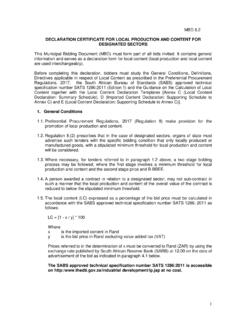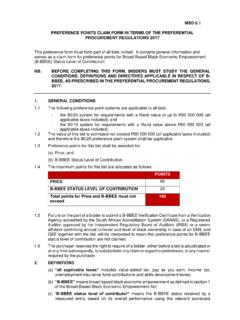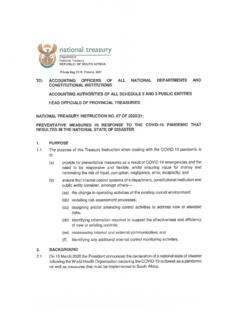Transcription of ASSET MANAGEMENT POLICY - Saldanha Bay Local Municipality
1 1 ASSET MANAGEMENT POLICY For implementation as from 1 July 2019 2 TABLE OF CONTENTS 1. DEFINITIONS AND ABBREVIATIONS 3 2. OBJECTIVE OF THE ASSET MANAGEMENT POLICY 5 3. ROLE OF THE ACCOUNTING OFFICER 5 4. ROLE OF THE CHIEF FINANCIAL OFFICER 5 5 ROLE OF OTHER DEPARTMENTS 8 6 DEFINITION OF AN ASSET 10 7 FORMAT OF THE ASSET REGISTER 11 8 CLASSIFICATION AND IDENTIFICATION OF PPE 13 9 HERITAGE ASSETS 15 10 DONATED/ BEQUEATHED ASSETS 16 11 AGRICULTURAL ASSETS 16 12 INTANGIBLE ASSETS 18 13 CAPITALISATION CRITERIA 20 14 CALCULATION OF CAPITALISATION COST OF ASSETS 21 15 RESIDUAL VALUES 23 16 DEPRECIATION OF ASSETS 24 17 REVALUATION OF ASSETS 29 18 DISPOSAL OF ASSETS 30 19 RECOGNITION OF ASSETS IN FINANCIAL STATEMENTS 33 20 FUNDING SOURCES 34 21 IMPAIRMENT LOSSES 35 22 INVESTMENT PROPERTY 37 23 REPLACEMENT STRATEGY 43 24 ASSET RISK MANAGEMENT 44 25 MAINTENANCE OF ASSETS 45 26 GENERAL REQUIREMENTS 46 3 1.
2 DEFINITIONS AND ABBREVIATIONS Item Description ASSET An ASSET is a resource, tangible or intangible, controlled by the entity as a result of past events which is expected to be used during more than one reporting period and from which future economic benefits or service potential will flow. ASSET MANAGEMENT of the assets of the Municipality as required by municipal legislation which inter alia includes the compilation of MANAGEMENT an ASSET register The amount at which an ASSET is included in the statement or Carrying Amount financial position after deducting any accumulated depreciation and any impairment losses thereon. CFO Chief Financial Officer or the official acting in that capacity The amount of cash or cash equivalents paid or the fair value Cost of the other consideration given to acquire an ASSET at the time of its acquisition or construction.
3 Depreciation This is the systematic allocation of the cost of use of an ASSET over its useful life. Depreciable The cost of an ASSET , or other amount substituted for cost in Amount the financial statements, less its residual value. The amount for which an ASSET could be exchanged or a Fair Value liability settled between knowledgeable, willing parties in an arm's length transaction. ASSET Register An ASSET register is a list of the assets owned or controlled by an entity. It contains pertinent details about each ASSET to track their value and physical location. ASSET Register preferably in computerized format and maintained strictly in accordance with this document, which shall reflect all the assets of the Municipality .
4 GRAP Standards of Generally Recognised Accounting Practice IAS International Accounting Standards Impairment An ASSET is impaired when the carrying amount exceeds its recoverable amount or recoverable service amount. Owner-occupied Property held (by the owner or by the lessee under a finance 4 Item Description Property lease) for use in the production or supply of goods or services or for administrative purposes PPE Property, Plant & Equipment These are tangible assets that: - are held for use in the production or supply of goods or services, for rental to others, or for administrative purposes and - are expected to be used during more than one reporting period Residual value The estimated amount that the Municipality would currently obtain from disposal of the ASSET after deducting the estimated costs of disposal, if the ASSET were already of the age and in the condition expected at the end of its useful life.
5 Recoverable The estimated amount which the Municipality expects to obtain Amount for an ASSET at the end of its useful life after deducting the expected costs of disposal. Recoverable service amount Recoverable service amount is the higher of a non-cash-generating ASSET s fair value less costs to sell and its value in use SCM Supply Chain MANAGEMENT Useful life Useful life is either: - the period over which an ASSET is expected to be available for use by the Municipality , or - the number of production or similar units expected to be obtained from the ASSET by the Municipality . Value in use Value in use reflects the amount that can be derived from an ASSET through its operation and its disposal at the end of its useful life.
6 5 2. OBJECTIVE OF THE ASSET MANAGEMENT POLICY The ASSET MANAGEMENT POLICY provides direction for the MANAGEMENT , accounting and control of Non-current Assets (Fixed Assets) owned or controlled by the Municipality . 3. ROLE OF THE ACCOUNTING OFFICER Section 63 of the MFMA states that:- (1) The Accounting Officer is responsible for the MANAGEMENT of (a) the assets of the Municipality , including the safeguarding and the maintenance of those assets; and (b) the liabilities of the Municipality . (2) The Accounting Officer must for the purposes of subsection (1) take all reasonable steps to ensure (a) that the Municipality has and maintains a MANAGEMENT , accounting and information system that accounts for the assets and liabilities of the Municipality ; (b) that the Municipality s assets and liabilities are valued in accordance with standards of generally recognised accounting practice; and (c) that the Municipality has and maintains a system of internal control of assets and liabilities, including an ASSET and liabilities register, as may be prescribed.
7 4. ROLE OF THE CHIEF FINANCIAL OFFICER The CFO shall be the custodian of the ASSET register of the Municipality , and shall ensure that a complete, accurate and up-to-date computerised ASSET register is maintained. No amendments, deletions or additions to the fixed ASSET register shall be made other than by the CFO or by an official acting under the written instruction of the CFO. 6 ASSET Control Section o Shall ensure that complete records of ASSET items are kept, verified and balanced regularly. o Shall ensure that all movable assets are properly tagged and accounted for. (see also ) o Shall conduct an annual ASSET verification by scanning selected movable assets and compare this inventory with the Departments ASSET sign-offs of the previous year.
8 (see also ) o The ASSET verification report shall reflect any discrepancies between the articles found during verification and the record referred to in the point above; o Shall ensure that the ASSET Register is balanced annually with the general ledger and the financial statements. o Shall ensure adequate bar codes to exercise the function relating to ASSET control are available at all times. o Shall provide the Auditor-General or his personnel, on request, with the financial records relating to assets belonging to Council as recorded in the ASSET Register. o Shall ensure that all audit queries are resolved in a timely manner. o Shall ensure that the relevant information relating to the calculation of depreciation is obtained from the departments and provided to the Finance department in the prescribed format.
9 O Shall ensure that ASSET acquisitions are allocated to the correct ASSET code. o Shall ensure that, a completed ASSET disposal form, counter signed by the ASSET Control Section, is presented. o Shall ensure that a verifiable record is kept of all obsolete, damaged and unused ASSET or ASSET inventory items received from the departments. o Shall compile, in conjunction with the stores controller, a list of the items to be auctioned in accordance with their guidelines in the Supply Chain MANAGEMENT (SCM) POLICY . o Shall compile and circulate a list of unused movable assets to enable other departments to obtain items that are of use to them. 7 The Manager: Budgets o Shall ensure that the capital budget as submitted by the departments after budget cutting and balancing process, and funded is included in the budget for consideration by council.
10 A clear description of the funding source is also required. o Shall include a capital project only after receiving written authority and a clear and concise description of the item to be purchased as well as an allocated responsible person for this ASSET . This information must be indicated by the department in the capital budget documents o Shall ensure that any changes in the capital budget, with regards to funds transferred or project description changes are communicated to the ASSET Control Section. The Manager: Expenditure section o Shall ensure that invoices authorised for payment are matched to the goods received note / proof before processing such payment. o Shall if any doubt exists as to whether the invoice is in accordance with POLICY , query the payment with the relevant department and shall not process a payment until the invoice meets the POLICY criteria.







